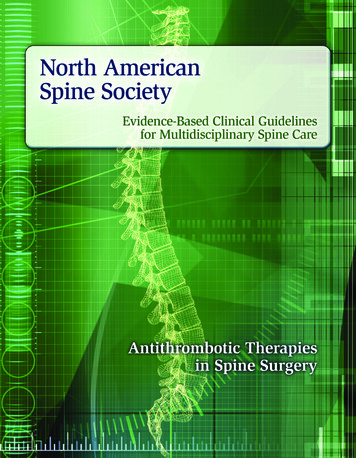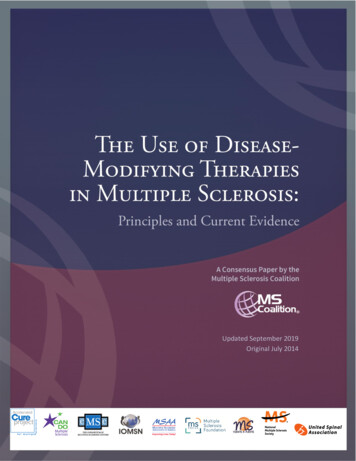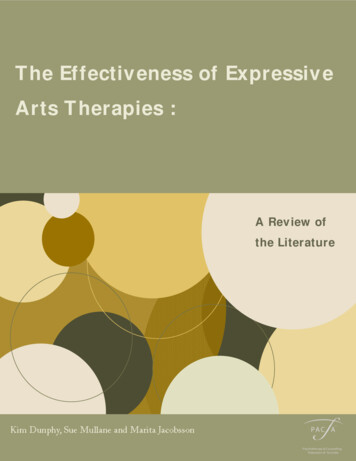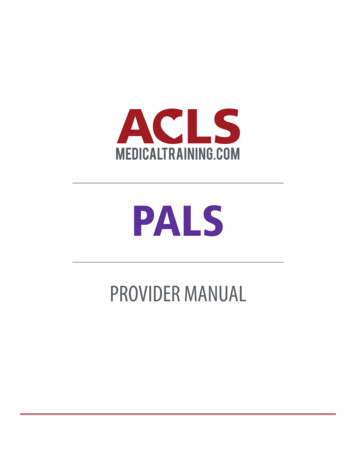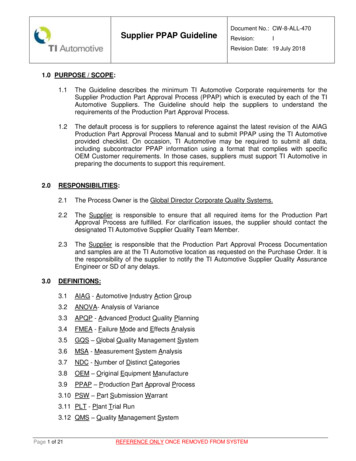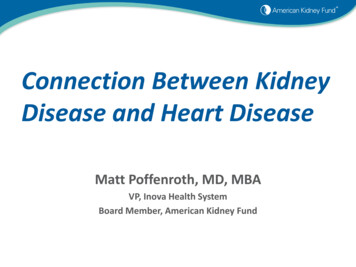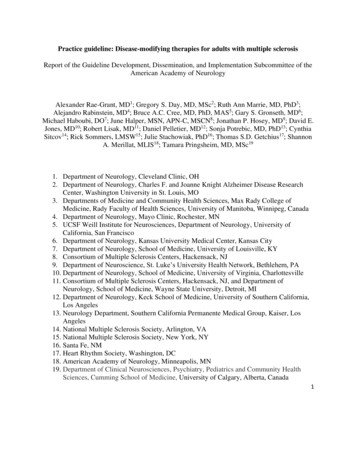
Transcription
Practice guideline: Disease-modifying therapies for adults with multiple sclerosisReport of the Guideline Development, Dissemination, and Implementation Subcommittee of theAmerican Academy of NeurologyAlexander Rae-Grant, MD1; Gregory S. Day, MD, MSc2; Ruth Ann Marrie, MD, PhD3;Alejandro Rabinstein, MD4; Bruce A.C. Cree, MD, PhD, MAS5; Gary S. Gronseth, MD6;Michael Haboubi, DO7; June Halper, MSN, APN-C, MSCN8; Jonathan P. Hosey, MD9; David E.Jones, MD10; Robert Lisak, MD11; Daniel Pelletier, MD12; Sonja Potrebic, MD, PhD13; CynthiaSitcov14; Rick Sommers, LMSW15; Julie Stachowiak, PhD16; Thomas S.D. Getchius17; ShannonA. Merillat, MLIS18; Tamara Pringsheim, MD, MSc191. Department of Neurology, Cleveland Clinic, OH2. Department of Neurology, Charles F. and Joanne Knight Alzheimer Disease ResearchCenter, Washington University in St. Louis, MO3. Departments of Medicine and Community Health Sciences, Max Rady College ofMedicine, Rady Faculty of Health Sciences, University of Manitoba, Winnipeg, Canada4. Department of Neurology, Mayo Clinic, Rochester, MN5. UCSF Weill Institute for Neurosciences, Department of Neurology, University ofCalifornia, San Francisco6. Department of Neurology, Kansas University Medical Center, Kansas City7. Department of Neurology, School of Medicine, University of Louisville, KY8. Consortium of Multiple Sclerosis Centers, Hackensack, NJ9. Department of Neuroscience, St. Luke’s University Health Network, Bethlehem, PA10. Department of Neurology, School of Medicine, University of Virginia, Charlottesville11. Consortium of Multiple Sclerosis Centers, Hackensack, NJ, and Department ofNeurology, School of Medicine, Wayne State University, Detroit, MI12. Department of Neurology, Keck School of Medicine, University of Southern California,Los Angeles13. Neurology Department, Southern California Permanente Medical Group, Kaiser, LosAngeles14. National Multiple Sclerosis Society, Arlington, VA15. National Multiple Sclerosis Society, New York, NY16. Santa Fe, NM17. Heart Rhythm Society, Washington, DC18. American Academy of Neurology, Minneapolis, MN19. Department of Clinical Neurosciences, Psychiatry, Pediatrics and Community HealthSciences, Cumming School of Medicine, University of Calgary, Alberta, Canada1
AcknowledgmentThe authors acknowledge the North American Research Committee on Multiple Sclerosis(NARCOMS) Registry for its assistance in administering an outcomes survey, the results ofwhich were included in this practice guideline. NARCOMS is supported in part by theConsortium of Multiple Sclerosis Centers (CMSC) and the Foundation of the CMSC.Address correspondence and reprint requests toAmerican Academy of Neurology:guidelines@aan.comApproved by the Guideline Development, Dissemination, and Implementation Subcommittee onOctober 9, 2017; by the Practice Committee on October 21, 2017; and by the AAN InstituteBoard of Directors on March 6, 2018.2
AUTHOR CONTRIBUTIONSDr. Rae-Grant: study concept and design, acquisition of data, analysis or interpretation of data,drafting/revising the manuscript, critical revision of the manuscript for important intellectualcontent, study supervision.Dr. Day: study concept and design, analysis or interpretation of data, drafting/revising themanuscript, critical revision of the manuscript for important intellectual content.Dr. Marrie: study concept and design, acquisition of data, analysis or interpretation of data,drafting/revising the manuscript, critical revision of the manuscript for important intellectualcontent.Dr. Rabinstein: analysis or interpretation of data, drafting/revising the manuscript.Dr. Cree: study concept and design, drafting/revising the manuscript, critical revision of themanuscript for important intellectual content.Dr. Gronseth: analysis or interpretation of data, critical revision of the manuscript for importantintellectual content, study supervision.Dr. Haboubi: study concept and design, analysis or interpretation of data, drafting/revising themanuscript.Ms. Halper: study concept and design, drafting/revising the manuscript, critical revision of themanuscript for important intellectual content.Dr. Hosey: critical revision of the manuscript for important intellectual content.Dr. Jones: study concept and design, drafting/revising the manuscript, critical revision of themanuscript for important intellectual content.Dr. Lisak: study concept and design, drafting/revising the manuscript, critical revision of themanuscript for important intellectual content.Dr. Pelletier: study concept and design, drafting/revising the manuscript, critical revision of themanuscript for important intellectual content.Dr. Potrebic: study concept and design, acquisition of data, analysis or interpretation of data,drafting/revising the manuscript, critical revision of the manuscript for important intellectualcontent, study supervision.3
Ms. Sitcov: study concept and design, drafting/revising the manuscript, critical revision of themanuscript for important intellectual content.Mr. Sommers: drafting/revising the manuscript, critical revision of the manuscript for importantintellectual content.Dr. Stachowiak: study concept and design, drafting/revising the manuscript, critical revision ofthe manuscript for important intellectual content.Mr. Getchius: study supervision.Ms. Merillat: drafting/revising the manuscript, study supervision.Dr. Pringsheim: study concept and design, acquisition of data, analysis or interpretation of data,drafting/revising the manuscript, critical revision of the manuscript for important intellectualcontent, study supervision.STUDY FUNDINGThis practice guideline was developed with financial support from the American Academy ofNeurology (AAN). Authors who serve as AAN subcommittee members or as methodologists(A.R.-G., G.S.D., A.R., G.S.G., M.H., S.P., T.P.), or who are or were AAN staff members(T.S.D.G., S.A.M.), were reimbursed by the AAN for expenses related to travel to subcommitteemeetings where drafts of manuscripts were reviewed. All authors on the panel were reimbursedby the AAN for expenses related to travel to 2 in-person meetings.DISCLOSUREA. Rae-Grant receives royalties from 2 textbooks he has published, 1 on neurology and 1 onmultiple sclerosis (MS); organizes and receives honoraria for ground rounds and neurologyreview courses; and is local primary investigator for a clinical trial with MedDayPharmaceuticals, for which he receives no personal compensation.A. Rabinstein has no relevant disclosures to report.4
B. Cree has received compensation for consulting from Abbvie, Biogen, EMD Serono, GeNeuro,Genzyme/Sanofi Aventis, Novartis, and Shire; has given expert testimony and prepared anaffidavit for medical malpractice cases (1 or 2 per year) within his area of expertise; and hasacted as consultant in a legal proceeding for Acorda and Biogen.G. Gronseth serves as associate editor (level of evidence review) for Neurology; serves on theeditorial advisory board for Neurology Now; and is compensated by the American Academy ofNeurology (AAN) for methodologic activities.G. Day holds stock in ANI Pharmaceuticals.M. Haboubi has received travel reimbursement and honoraria for grand rounds presentations inMadisonville, Kentucky.J. Halper has no relevant disclosures to report.J. Hosey has no relevant disclosures to report.D. Jones has received personal compensation for consulting from Biogen and Genzyme; hasreceived honoraria from the Consortium of Multiple Sclerosis Centers (CMSC), the MultipleSclerosis Association of America (MSAA), and the Pharmacy Quality Alliance (PQA); hasreceived institutional research support from Biogen and the National MS Society (NMSS); hasreceived salary support from the CMSC; and has received travel reimbursement from Biogen andGenzyme and from the AAN, Can Do MS, the CMSC, and the MSAA.R. Lisak served as the President of the CMSC and serves as a member of the Board of the DMCFoundation; has served on scientific advisory boards for Mallinckrodt, Syntimmune, Celegene,and Alexion; serves as chair of the adjudication committee of a clinical trial (PAREXEL); has5
received funding for travel from the CMSC, the GBS/CIDP Foundation, the NMSS, andSyntimmune for travel to consultants meetings; has served as a journal editor for Clinical andExperimental Neuroimmunology and Clinical Neuropharmacology; has received publishingroyalties from Willey for International Neurology, A Clinical Approach; has received honorariafrom Mallinckrodt, Syntimmune, and Teva Pharmaceuticals, and from the consulting agenciesAlphaSights, ClearView Healthcare Partners, GLC, and Insights Consulting; has served on aspeakers bureau for Teva Pharmaceuticals for talks unrelated to pharmaceuticals; has receivedresearch support from Mallinckrodt for investigator-initiated wet bench studies, and fromAcorda, Avanir, Biogen, Chugai, Genentech, MedImmune, Novartis, and Teva Pharmaceuticalsfor serving as a site investigator in multicenter trials; has given expert testimony, prepared anaffidavit, and acted as witness for Teva Pharmaceuticals; and has acted as an expert on a patentcase for Acorda. Wayne State University has received financial compensation from the NMSSfor his salary as principle investigator for a research grant.R.A. Marrie receives research grants from nonprofit organizations, including Canadian Institutesof Health Research (CIHR), the CMSC, Crohn’s and Colitis Canada, the NMSS, the MultipleSclerosis Society of Canada, the Multiple Sclerosis Scientific Research Foundation, andResearch Manitoba; and serves on the editorial board of Neurology.D. Pelletier has served on scientific advisory boards for Biogen, EMD Serono, Genzyme/SanofiAventis, Hoffman LaRoche, and Novartis; has received research support for Biogen, Genzyme,Hoffman LaRoche, and the National Institute of Neurological Disorders and Stroke (NINDS) ofthe NIH; and has received honoraria for providing consulting services at scientific advisoryboard meetings from Biogen, EMD Serono, Genzyme/Sanofi Aventis, Hoffman LaRoche, andNovartis.S. Potrebic S receives travel reimbursement from the AAN for attending AAN Residency InService Training Examination Work Group meetings, AAN Axon Registry Committee meetings,AAN Guideline Development, Dissemination, and Implementation Subcommittee meetings, andthe Guidelines International Network North America E-GAPPS (Evidence-based GuidelinesAffecting Policy, Practice, and Stakeholders) conference.R. Sommers reports no relevant disclosures.6
C. Sitcov reports no relevant disclosures.J. Stachowiak reports no relevant disclosures.T. Getchius is a former AAN employee and reports no relevant disclosures.S. Merillat reports no relevant disclosures.T. Pringsheim has received research support from the CIHR and Shire Canada Inc.7
ABBREVIATIONSAAN: American Academy of NeurologyAEs: adverse effectsALT: alanine aminotransferaseARRs: annualized relapse ratesAST: aspartate aminotransferaseCIS: clinically isolated syndromeCMSC: Consortium of Multiple Sclerosis Centers”COI: conflict of interestCV: curriculum vitaeDMTs: disease-modifying therapiesEDSS: Expanded Disability Status ScaleFDA: US Food and Drug AdministrationGDDI: Guideline Development, Dissemination, and Implementation SubcommitteeIOM: Institute of MedicinemIUs: milli-international unitsMS: multiple sclerosisNARCOMS: North American Research Committee on Multiple SclerosisPML: Progressive multifocal leukoencephalopathyPPMS: primary progressive MSRCTs: randomized controlled trialsRD: risk differenceREMS: risk evaluation and mitigation strategiesRMD: raw mean differenceRR: risk ratioRRMS: relaxing remitting MSSAEs: serious adverse effectsSMD: standardized mean differenceSPMS: secondary progressive MS8
ABSTRACTObjective: To review evidence on starting, switching, and stopping disease-modifying therapies(DMTs) for multiple sclerosis (MS) in people with clinically isolated syndrome (CIS),relapsing remitting MS (RRMS), and progressive forms of MS; and to developrecommendations for starting, switching, and stopping DMTs.Methods: The guideline panel followed the American Academy of Neurology (AAN) 2011guideline development process, as amended. Relevant, peer-reviewed research articles,systematic reviews, and abstracts were identified using a literature search of MEDLINE,CENTRAL, and EMBASE published from database inception to November 2016. Studies wererated (Class I–IV) using the AAN therapeutic classification of evidence scheme. The systematicreview also used prior published Cochrane reviews on DMT for MS. Recommendations weredeveloped using the AAN process, including a modified Delphi process. People with MS wereinvolved throughout the guideline development process, and 2 public review periods were held.Results: Twenty Cochrane reviews and an additional 73 full-text articles were selected for dataextraction through an updated systematic review, completed in November 2016. In people withRRMS, many DMTs are superior to placebo as measured by annualized relapses rates (ARRs),new disease activity as measured by new MRI T2 lesion burden, and in-study diseaseprogression (see summary and full-text publications). For people with RRMS who experienced arelapse while using interferon beta or glatiramer acetate, alemtuzumab is more effective thaninterferon beta-1a 44 micrograms subcutaneous 3 times per week in reducing the ARR. Forpeople with primary progressive MS, ocrelizumab is probably more effective than placebo asmeasured by in-study disease progression. DMT for MS have varying adverse effects. In peoplewith CIS, glatiramer acetate and interferon beta-1a subcutaneous 3 times per week are moreeffective than placebo in decreasing the risk of conversion to MS. Cladribine, immunoglobulins,interferon beta-1a 30 micrograms intramuscular weekly, interferon beta-1b subcutaneousalternate day, and teriflunomide are probably more effective than placebo in decreasing the riskof conversion to MS.Recommendations: The guideline panelists made 17 starting, 10 switching, and 3 stoppingrecommendations, each supported by structured rationales. These recommendations includedpatient engagement strategies and individualization of treatment, a focus on monitoring ofadherence, and assessment of disease comorbidities. The panelists also includedrecommendations for who should start a DMT, including people with RRMS and people with asingle clinical demyelinating event and 2 or more brain lesions characteristic of MS who decidethey want to take DMTs. The panelists included recommendations for switching wherebreakthrough disease occurs. They also discussed DMT risks, including counseling aboutprogressive multifocal leukoencephalopathy risk in people with MS taking natalizumab,fingolimod, rituximab, ocrelizumab, and dimethyl fumarate. The panelists made suggestions for9
future research, including higher potency treatment initially vs standard stepped-care protocols,longer term studies, studies focused on patient-centered outcomes, comparative effectivenessstudies, better definitions of highly active MS, and studies of various switching strategies.10
INTRODUCTIONMultiple sclerosis (MS) affects more than 400,000 people in the United States, and more than 2.3million people have MS worldwide.e1 In the United States, annual direct (health-related) costsare estimated to be 24,000 or more for people living with MS than for those without MS.e2MS is considered an immune-mediated demyelinating disease of the CNS, characterized onhistopathology by focal perivenular infiltrates of leukocytes (primarily macrophages andlymphocytes) and plaque formation.e3,e4 In acute plaques, oligodendroglial cells are injured, withrelative axonal sparing, although many axons are also transected. In these plaques, macrophagesstain positively for myelin antigens, indicating active scavenging of myelin debris. Chronicplaques show astrogliosis, with fewer inflammatory cells seen compared with acute plaques. Inpeople with progressive MS, widespread microglial activation is seen in addition to focalplaques. Cortical plaques are common in early and late MS. These cortical plaques are notassociated with venules and are likely caused by direct pial infiltration by inflammatory cells.Wallerian degeneratione5 and mitochondrial dysfunctione6 are thought to contribute to gradualworsening of function and to brain and spinal cord volume loss. Ectopic meningeal, perivascular,and intraparenchymal lymphoid follicle like structures of B cells have been found.e7 In somecases, meningeal lymphoid follicle like structures are associated with underlying corticalplaques, suggesting that secreted factors from follicles may contribute to demyelination.Extensive immunologic studies of peripheral blood show differences in immune regulationbetween persons with MS and unaffected controls. These differences include alterations in theproportions of regulatory T cells and different patterns of cytokine expression. Many CNSautoimmune diseases, such as neuromyelitis optica or N-methyl-D-aspartate receptorencephalitis, are associated with pathologic antibodies directed against a specific target.e8However, in MS, all attempts at identifying antigen-specific targets have been unsuccessful,including logical potential candidates such as myelin proteins (e.g., myelin basic protein, myelinoligodendrocyte glycoprotein, and proteolipid protein).e9 Analysis of oligoclonal bands has alsofailed to reveal a consistent antibody pattern across people with MS.e10 Cloned antibodies fromCSF oligoclonal bands have not revealed a common antigenic target.e11 Thus, intrathecalsynthesis of gamma globulins, the immunochemical hallmark of MS, does not appear to beassociated with specific CNS targets.e12,e13Despite an inability to conclusively determine an autoimmune target in people with MS, thesuccess of clinical trials evaluating a wide variety of immune-modulating or immune11
suppressing treatments strongly supports immune-mediated mechanisms of diseasepropagation.e14 Since 1993, multiple disease-modifying therapies (DMTs) have been approved inthe United States for the treatment of relapsing forms of MS; most of these therapies areapproved for use in other countries. In addition, many other medications have been used off labelfor disease modification of MS. Effective medications share several features: (1) All effectivemedicines modify measures of disease activity such as relapse rates, the emergence of new orenhancing lesions on MRI, disability, or other parameters. (2) None of these medications iscurative. (3) All these medications may have adverse effects (AEs), which may vary frombothersome to life-threatening.Although the disease course is known to vary widely, life expectancy may be shortened by about6 to 7 years in persons with MS.e15 In addition, in many people with MS, progression of thedisease ultimately leads to severe disability.e16 Early studies suggested that most individuals withrelapsing remitting MS (RRMS) make the transition to secondary progressive MS (SPMS) ifobserved for long enough intervals.e17 These statistics challenge clinicians to manage and controldisease activity in the interest of helping persons with MS maintain a vibrant and meaningfullife.The 2002 American Academy of Neurology (AAN) clinical practice guideline on DMTs inMSe18 systematically reviewed injectable medications then approved for use in people with MS,including interferon beta-1b (interferon beta-1b subcutaneous alternate day: BETASERON),interferon beta-1a IM (interferon beta-1a IM weekly: AVONEX), interferon beta-1asubcutaneous (interferon beta-1a subcutaneous 3 times per week [Rebif]) and glatiramer acetate(COPAXONE). Medications commonly prescribed off label for the treatment of MS were notreviewed (e.g., azathioprine, cyclophosphamide, mycophenolate mofetil).e18 The treatmentlandscape has changed considerably since then, with more than 17 medications currentlyapproved and widely prescribed for treating MS in the United States, and other agents nearingcommercial approval. As a result, clinicians and people with MS may now choose from severalmedications, with differing mechanisms of action, risk profiles, and monitoring requirements.These additional options have increased interest in comparing different medications for whichspecific data may not be available.e12,e19 In addition, changes in the diagnostic criteria for MSe20in 2010, and modification of the classification scheme for MS subtypese21 in 2014, havecomplicated the extension of efficacy data from clinical trials to particular subgroups of peoplewith MS. Before recommending a specific therapy, the clinician must navigate thesecomplexities while carefully balancing the potential for therapeutic benefits of a medication withpatient preferences, monitoring recommendations, drug- and individual-specific risk factors, andconcerns regarding the long-term risk of MS-related disability and morbidity.12
Recognizing all of this, AAN members and leadership articulated a strong need for a practiceguideline reflective of the current evidence landscape and specific to the prescribing of DMTs topeople with MS. Because of these complexities, an up-to-date practice guideline focusing onthese medications is essential to AAN members and other clinicians committed to the delivery ofoptimal care to people with MS.This practice guideline reviews indications for the use of DMTs in people with MS; counselingbefore and during use of DMTs; patient preferences regarding DMT use; matters pertinent toswitching or stopping DMTs; and indications for use in different MS types (RRMS, SPMS,primary progressive MS [PPMS]). Potential AEs related to DMT use are also reviewed,including AEs that may have an impact on medication tolerability, and uncommon events thatmay have serious, even irreversible, consequences for the patient. When available, dataconcerning patient preference and patient-prioritized outcomes for treatment were expresslyanalyzed (AAN guideline development process manual).e22 Data from RCTs were preferred.When sufficient Class I and II evidence (appendix e-4) was not available, related evidence andpractical axioms of care were used to develop recommendations, consistent with the guidelinedevelopment process.e22 In addition, the 5 members of the guideline panel (G.S.D, A.R.-G.,M.J.A., T.P., R.A.M.) solicited opinions concerning outcome measures of importance from theother guideline panelists and people with MS (the latter consulted through the North AmericanResearch Committee on Multiple Sclerosis [NARCOMS] registry) using a formalized process.Perceived health benefits, AEs, and risks were formally considered in recommendationdevelopment. This methodology ensures that recommendations are evidence-driven andpracticable but does not diminish the importance of interpreting recommendations on a patientby-patient basis, accepting that systematic differences between people with MS enrolled in RCTsand those encountered in clinical practice (i.e., generalizability) may affect the translation offindings into practice.The guideline panel developed clinical questions and disseminated them for public review in theguideline protocol before the initial systematic review. The initial public review indicated noneed for substantive changes to the clinical questions. Adequate evidence was available toaddress the following questions:1. In people with RRMS, are DMTs superior to placebo or other DMTs as measured byannualized relapse rates (ARRs)?2. In people with RRMS, are DMTs superior to placebo or other DMTs in reducing MRIdetected new disease activity as measured by new T2 lesion burden or atrophy measures?13
3. In people with RRMS, are DMTs superior to placebo or other DMTs in preventing diseaseprogression as measured by in-study disease progression measures?4. In people with RRMS who experience disease activity while using a DMT, is changing to adifferent DMT superior to continuing the present DMT in terms of relapse rate and MRI-detectedT2 or gadolinium-enhanced lesion activity?5. In people with progressive MS, are DMTs superior to placebo or other DMTs as measured byrelapse rate or in-study disease progression?6. What are the AEs of DMTs in people with MS compared with placebo (AE-relateddiscontinuation and serious or life-threatening AEs)?7. In people with clinically isolated syndromes (CIS), are DMTs superior to placebo indecreasing the risk of conversion to MS?14
DESCRIPTION OF THE ANALYTIC PROCESSIn May 2015, the AAN Guideline Development, Dissemination, and ImplementationSubcommittee (GDDI) recruited a multidisciplinary panel to develop this practice guideline. Thepanel consists of 12 AAN physician and nurse members, 2 representative members from theConsortium of Multiple Sclerosis Centers (CMSC), and 3 patient representatives (appendices e-1and e-2). Two AAN staff representatives were also appointed to the panel. The physiciansinclude content experts (R.A.M., B.A.C.C., J.H., D.E.J., D.P.); a methodology expert (T.P.);GDDI members (A.R.G., G.S.D., A.R., G.S.G., M.H., S.P.); and CMSC representatives (J.H.,R.L.). The patient representatives (C.S., R.S., J.S.) are 3 adults with an MS diagnosis. They wereinvolved as authors throughout the guideline development process and fully participated indevelopment and refinement of the clinical questions, in identification of outcomes important topatients, and in the drafting of and voting on recommendations. All panel members wererequired to submit online conflict of interest (COI) forms and copies of their curriculum vitae(CV). The panel leadership, consisting of the lead author (A.R.G.), the AAN methodologist(T.P.), and the AAN staff persons (T.S.D.G., S.A.M.), reviewed the COI forms and CV forfinancial and intellectual COI. These documents were specifically screened to exclude not onlyindividuals with a clear financial conflict but also those whose professional and intellectualbiases might diminish the perceived credibility of the review. In accordance with AAN policy,the lead author (A.R.G.) has no COI. Four of the 20 authors were determined to have COI, whichwere judged to be not significant enough to preclude them from authorship (B.A.C.C., D.E.J.,R.L., D.P.). All authors determined to have COI were not permitted to review or rate theevidence. These individuals were involved in an advisory capacity to help validate key questions,assess the scope of the literature search, identify seminal articles to validate the literature search,and participate in the recommendation development process. AAN GDDI leadership providedfinal approval of author panel composition. This panel was solely responsible for decisionsconcerning the design, analysis, and reporting of the proposed systematic review, which was thensubmitted for approval to the AAN GDDI.This practice guideline follows the methodologies described in the 2011 edition of the AAN’sguideline development process manual, as amended to include an updated classification schemefor therapeutic studies, a formalized prioritization process for guideline topic nominations, and achange in the order of steps for the external (peer) review process.e22 The guideline panelistssummarize the process here and provide a detailed description in the appendices referenced later.This process is compliant with Institute of Medicine (IOM) standards for guideline development;IOM standards were specifically reviewed and adhered to during the guideline developmentprocess.e22 Over the course of guideline development, the public and experts had an opportunityto review the draft protocol during a 30-day public comment period, during which the documentwas posted on the AAN Web site. During this period, AAN staff sent invitations to review andcomment on the guideline to key stakeholders, including all AAN section members, and15
pertinent external physician and patient organizations, including the CMSC, the MultipleSclerosis Association of America, the Multiple Sclerosis Coalition, and the National MultipleSclerosis Society. All comments during public review were individually addressed by the paneland, where appropriate, led to modification of the draft guideline or recommendations, orinformed the updated systematic review. The guideline was reviewed by the GDDI before andafter the public comment period.Panel members developed the clinical questions and the data extraction template. The guidelinepanel defined DMTs as medications that aim to affect the clinical course of MS by decreasingrelapses or slowing disease progression or both. The guideline panelists limited the search forrelevant literature to medications that have been approved by the US Food and DrugAdministration (FDA), Health Canada, or the European Medicines Agency, or to medicationshistorically used for disease modification in MS but which were not licensed for this purpose.When disputes arose concerning whether a medication should be included, the panel erred on theside of inclusion (e.g., corticosteroids for disease modification and cladribine). In addition,agents which potentially would receive licensure within the timeframe of the guideline processwere included. For example, the FDA approved daclizumab May 2016 and ocrelizumab March2017. After FDA approval was received, daclizumab (ZINBRYTA) was voluntarily removedfrom the market on March 2, 2018, by its manufacturers, Biogen and AbbVie, due to seriousadverse events in relapsing MS.e22a Medications still in early phases of clinical testing were notincluded. With this strategy, 23 medications were identified and included in the initial andsubsequent systematic reviews: methotrexate, cyclophosphamide, pulsed corticosteroids fordisease modification, interferon beta (4 types: interferon beta-1b subcutaneous alternate day,interferon beta-1a intramuscular [IM] weekly, pegylated interferon subcutaneous every otherweek, interferon beta-1a subcutaneous 3 times per week), glatiramer acetate
4. Department of Neurology, Mayo Clinic, Rochester, MN 5. UCSF Weill Institute for Neurosciences, Department of Neurology, University of California, San Francisco 6. Department of Neurology, Kansas University Medical Center, Kansas City 7. Department of Neurology, School of Medicine, University of Louisville, KY 8.


